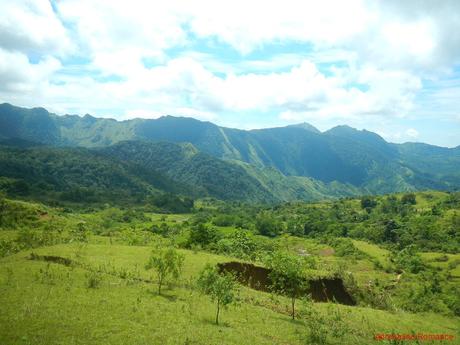
In the world of traveling and adventure, it is not often that we get the honor to be among the new kids on the block. By that, we mean that it is a great privilege for us to set foot on rarely visited but stunningly beautiful places in our country. Thus, we were elated when we learned that we were going to spend a night and half a day in the highlands of San Remegio, one of Antique’s less visited municipalities. San Remegio is a green region known for its healthy vegetable produce, but we found out there is so much more to this magnificent highlands than just crops.
We arrived at Barangay Aningalan, San Remegio at around 8 PM. The evening mountain air chilled us to the bones; we could not stop shivering! So, after a hurried but delicious dinner in a roadside restaurant, we immediately headed towards our assigned homestay where it was comfortably warmer.
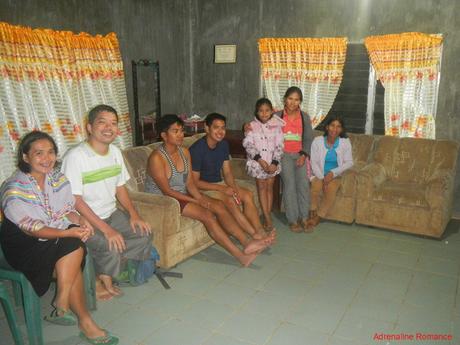
We woke up to a still chilly day. The high altitude, fertile soil, and the cool, fresh climate of San Remegio allows colorful, exotic flowers like these to grow strong and healthy.
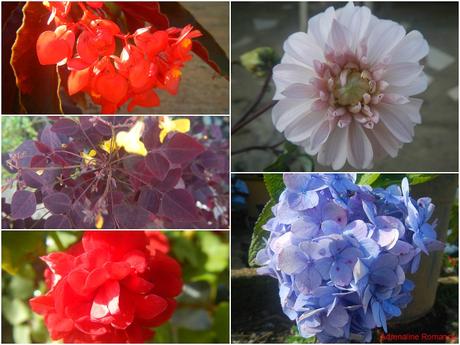
Lubid-Lubid Making Demo
After a hot breakfast, locals demonstrated how to make lubid-lubid, a specialty sweet pastry. Lubid-lubid is named so because it resembles a twisted rope (lubid in Tagalog).
First, the dough is kneaded, rolled, and formed into twisted cylinders.
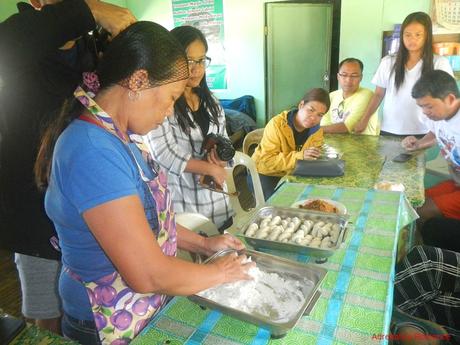
That’s the raw dough, and no, they are not ready to eat yet. This is Panay’s version of Western pretzels.
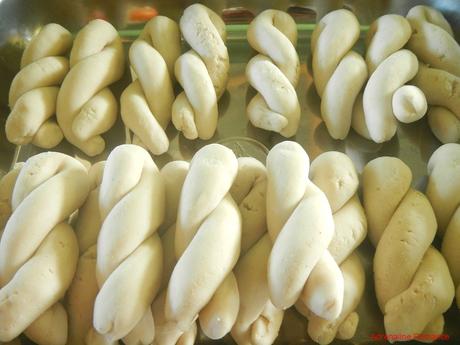
The other main ingredient of lubid-lubid is dark brown muscovado sugar. This is raw, unrefined sugar characterized by a strong molasses flavor. Muscovado sugar is used as an important ingredient in many sumptuous Filipino desserts.

One of the locals prepared an old wood-fired stove where the twisted pastries will be cooked. Rather than baking, the twisted pieces of dough are fried in vegetable oil until they turn light brown.
While the pastries are set aside to cool, the old lady placed another clean wok on the stove. She added muscovado sugar to a few cups of water to make a thick, dark syrup. The pastries are then folded into the mixture until all the sides are covered with the muscovado syrup.
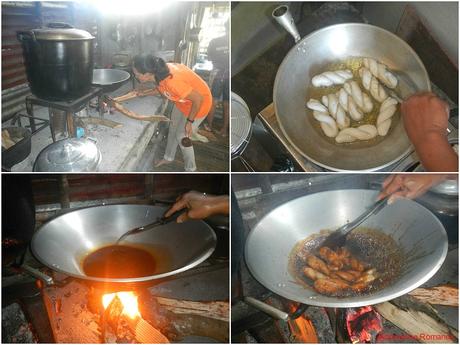
Here are the finished lubid-lubid. They are deliciously sweet, and they go very well with coffee or tea.
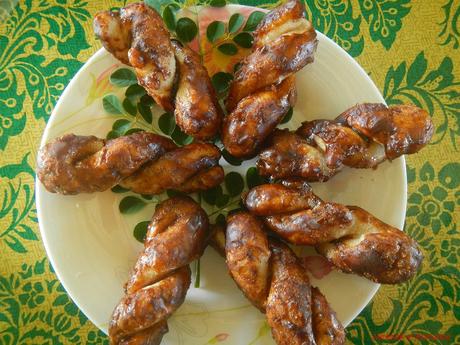
After packing the freshly cooked lubid-lubid (we were going to snack on them later), we headed uphill to Barangay Igbaclag. Habal-habals, bicycles, or 4X4 off-road vehicles such as our pick-up truck were, for the moment, the only vehicles that can go over the extremely rough and muddy road.
As of the date of this writing, the mountain road that connects Iloilo and San Remegio is still being constructed. In a year or so, this highway will be completed.
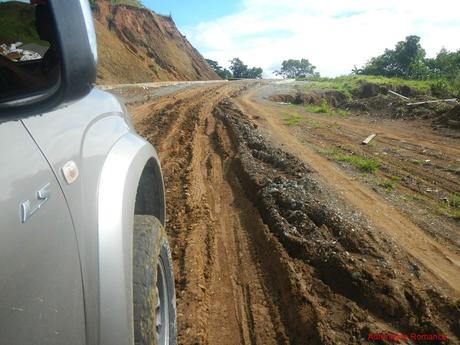
The high altitude and the cool weather enable tall pine trees like these to thrive. Oh, an interesting thing happened the night before. While we were going up to Barangay Aningalan, we saw clouds of fireflies lighting up these pine trees. They look like twinkling Christmas lights!
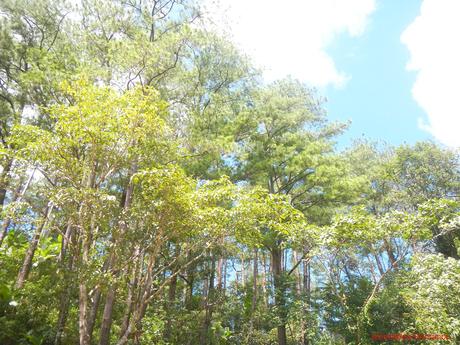
Igbaclag Cave
In less than 30 minutes, we steered off the road and entered this grassy area in Barangay Igbaclag. Except for us and a few caretakers, the place is virtually devoid of people. But apparently, it’s an upcoming tourist attraction because of the presence of brand-new open-air sheds.
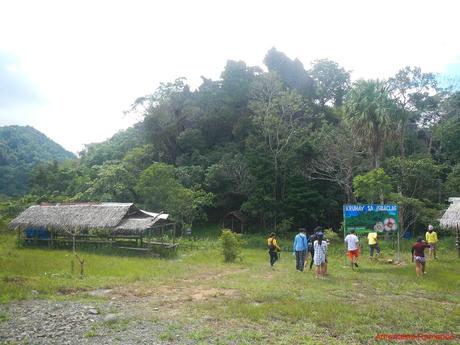
We followed a short trial into the woods. Because it rained last night, the trail was quite wet and muddy. The local tourism officers must have known this as there were convenient stepping stones along the trail.
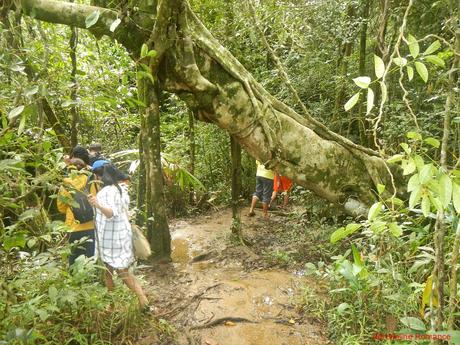
Our destination was this remarkable moss-covered monolith. There were many holes, caverns, and cavities that we can see from where we stand. This suggests that the monolith was once solid, and the hollow spaces within are the results of water and wind erosion.
One of these cavities is the barangay’s attraction, the Igbaclag Cave.
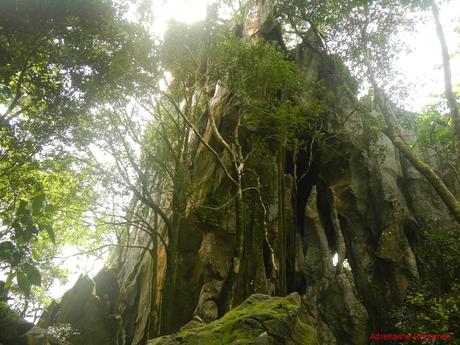
To get inside the monolith, we had to cross this rickety bridge made of steel cables. Because the bridge is suspended over a 20-foot chasm, it sways and bounces with every step. Exciting for some, heart-pounding for others.
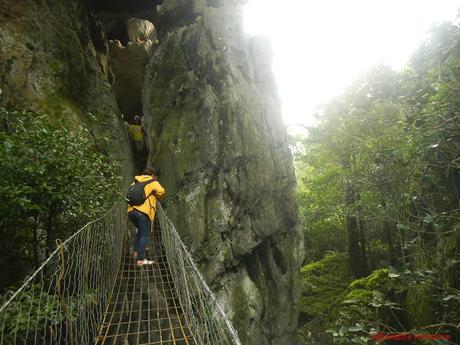
Across the monolith are more gnarly rock formations that are chiseled by the constant, unceasing forces of Mother Nature. They are definitely not climbable due to their completely moss-covered surfaces.
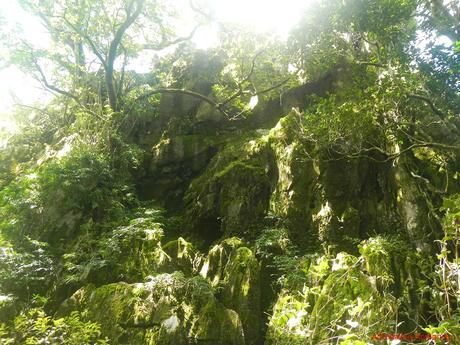
Due to its material composition and its chemical reaction to water, limestone karst formations such as these are easily prone to erosion. That’s why many of the most spectacular caves and caverns in the world are found in limestone cliffs, mountains, and monoliths.
Igbaclag Cave is not strictly a cave but a large open-air cavern. There may be other cave systems that lead deeper into the monolith. But we didn’t go inside them since we don’t have the equipment, and the guides are not familiar with the subterranean system.
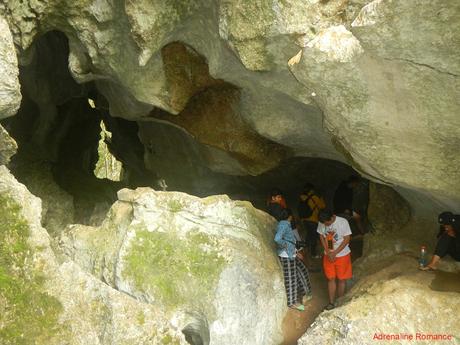
What is this glob? Is this an alien? Nope, that is some type of fungi. It’s totally terrestrial although calling it an alien would be equally fitting. The world is full of unnameable wonders.
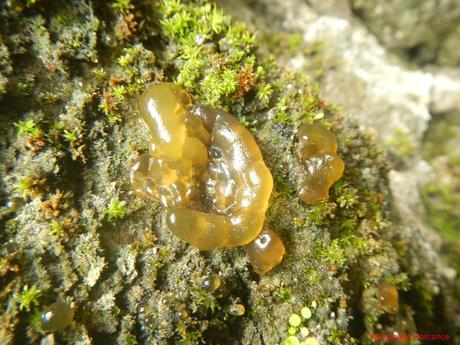
Whenever we see large rock formations, the rock climbers in us awaken. Hehe! Thus, when Sweetie and I saw this cavity inside the monolith, we felt elated. There were large protrusions and adequately deep cavities. With permission for the tourism officers, we climbed 40 feet up this chimney filled with razor-sharp rocks.
Because we didn’t bring harnesses, ropes, cams, and other equipment, we ascended this chimney free solo. Free solo climbing is a form of climbing that involves no protective equipment. It is the purest form of climbing; we simply relied on our ability and confidence.
Note: Free solo climbing is extremely dangerous! A fall from this height is absolutely injurious and most probably fatal! We did this because the climbing difficulty was way below our normal level, and we were confident that we ascend the chimney. But NEVER overestimate yourself. If you feel you can’t climb this section, then you probably shouldn’t do it. Always be on the safe side.
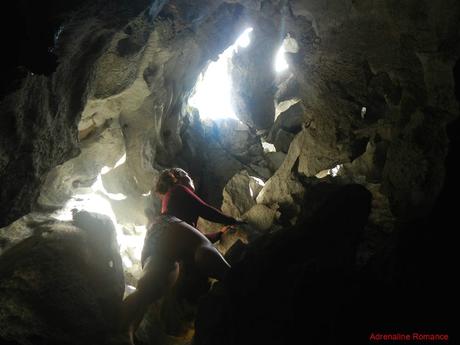
In less than five minutes, we were emerged on top of the rock formation. The wondrous scenery of San Remegio spread before us like a lost, hidden world. After the risk and danger we faced in climbing its gateway, enjoying this awesome reward, an all-encompassing view of the remaining rainforests of Igbaclag.
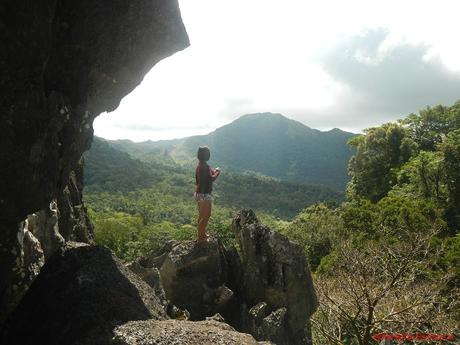
Sweetie sat silently while enjoying the lofty, untouched rain forest below her. Rain forests are extremely vital for the planet’s survival. They stabilize planetary climate by recycling water vapor, and they have a significant role in cloud formation. Untouched rain forests also help control global warming by absorbing massive quantities of carbon dioxide in the atmosphere.
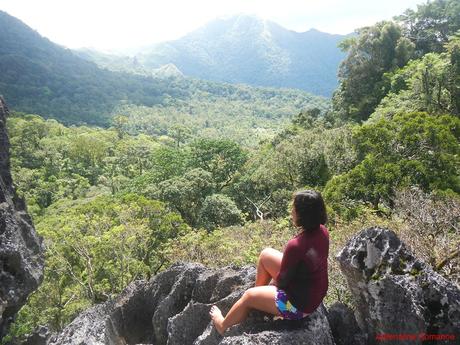
This is a pretty precarious position; I’m standing on a “bridge” of sharp rocks. To my left is a 40-feet drop, the chimney where we climbed from. To my immediate right is a 60-foot cliff towards the rain forest.
The rain forest of Igbaclag connects the Sibalom Natural Park to the forests of the Central Panay mountain range. It has an important role of ensuring genetic connectivity between those important forests. They ensure that flora and fauna can move and grow unhindered between those areas.
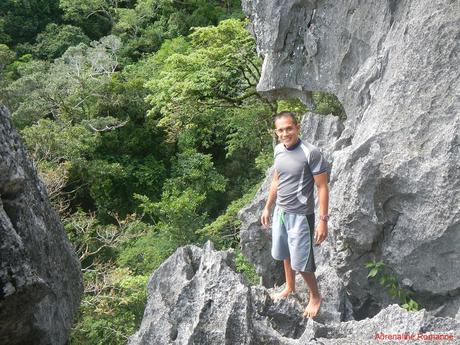
Later, we heard cries in the air. To our delight, the sounds came from several hawks emerging from the forest. They’re probably out to hunt for breakfast.
We feel honored and privileged to visit untouched places like these. Not only does these vistas give a sense of awe and wonder, they also make us realize just how small we are in the grand scheme of things. We do not own these planet, but we all have an important part to preserve and protect it.
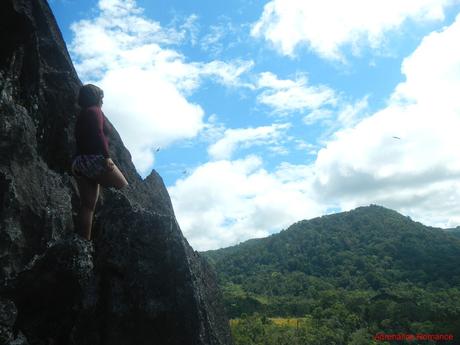
We climbed down, rejoined the team, snacked on some lubid-lubid at the tourist area, and headed back to Barangay Aningalan to pick up our packs. Our driver had a surprise for us, and we stopped by this green hill that offers an encompassing view of the valley below. Many of us felt the need to exuberantly and compulsively sing, “The hills are alive with the sound of music!”
San Remegio is the fruit and vegetable basket of Antique. Thanks to the region’s high elevation, cool climate, unpolluted air, and healthy topsoil, crops here grow healthy. In fact, the vegetable dish we ate for dinner last night has a vastly better, fresher taste than similar vegetable dishes we have tasted in the lowlands.
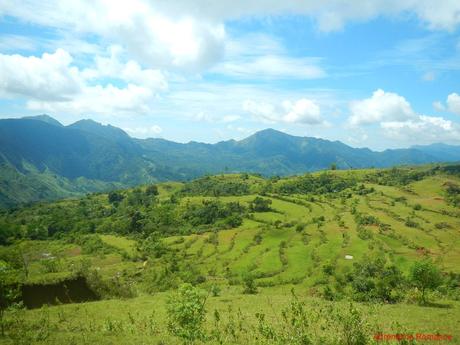
All too soon, we were riding back towards the lowlands to meet up with our van, which was waiting for us at the foot of the mountain.
We were totally grateful for being some of the few visitors who have set foot in this quiet part of Antique. The virgin nature of San Remegio denotes that there are still so many natural, pristine wonders to see and explore. The communities, touched by a good balance of modernity and tradition, makes it a perfect destination for cultural immersion. The climate, fresh and cool, makes it a potential summer capital like Baguio where people can seek refuge from the heat of the glaring sun.
Visit San Remegio now!
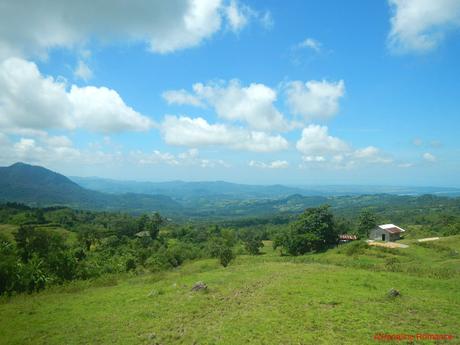
Contact Details
To facilitate your tour around San Remegio, Antique, get in touch with the following:
- Ms. Charity Sanchez (Barangay Aningalan Tourism Officer), 0908-566-3379
- Mr. Flord Calawag (OIC Antique Provincial Tourism Office) – 0927-699-5727 / 0919-813-9893
- Ms. Jola Lyn Tingson (Antique Natural Tourism Program Head) – 0977-811-0017
- Email: [email protected]
- Website: Province of Antique
- Phone Number: 0995-5034544
We strongly recommend contacting any of these officers before your trip so they can coordinate with the accommodation providers and the necessary people to help you in your cultural immersion.
Once you arrive in San Remegio, head first to the municipal hall to register. Then see the tourism officer/staff for assistance.
Itinerary
Since San Remegio is in the highlands and deep into Antique, we provided instructions on how to get there. The information below is given by the tourism officers.
Option A
1. From Iloilo, ride a bus to San Jose.
2. From San Jose, ride a jeepney to Sibalom.
3. From Sibalom, ride a jeepney to San Remegio. There are only two jeepney trips to Sibalom per day, but the only schedule we know is the 12-noon trip.
Option B
1. From Kalibo, ride a bus to Sibalom.
2. From Sibalom, ride a jeepney to San Remegio. See above.
Option C
1. Get to Sibalom as stated in Options A and B.
2. Ride a habal-habal to San Remegio.
Rates*
Transportation (same rates apply on the return trips)
- P 60 to P 80 per person – bus fare from Iloilo City to San Jose
- P 13 per person – jeepney fare from San Jose to Sibalom
- P 30 per person – jeepney fare from Sibalom to San Remegio
- P 100 to P 120 per person – bus fare from Kalibo to Sibalom
- P 300 per person (one way) – habal-habal fare from Sibalom to San Remegio
- Guide fee and registration fee – ask the tourism officer
* Rates are subject to change without prior notice. We did not include our expenses for guide fees, meals, snacks, souvenirs, accommodations, tips, and other fees in this rate sheet as you may have different needs, preferences, itineraries, and sharing scheme from us.
Tips
1. For large groups or for a more private tour, you can hire an air-conditioned van from Southwest Tours. Use the following contact details:
- Cellphone Numbers: 0917-568-2441 or 0947-891-1658
- Email: [email protected]
2. Aside from the Igbaclag Cave, there are other natural attractions in San Remegio. They have a Rafflesia site and massive rice terraces in Barangay General Fullon. The latter is a recently discovered heritage community, which requires a 4 to 5 hour trek through the mountains. Contact the tourism officers above and ask for assistance if you want to visit the place.
3. Because the communities in San Remegio are laid back and far from civilization, there are no hotels, mountain resorts, inns, or beds and breakfasts. The primary accommodations are homestays. Get in touch with the tourism officers above and ask for assistance in booking your stay.
4. Since there are hardly any public transportation going around San Remegio, your best bet to see the wonders is by hiring a habal-habal. Again, you can ask help from the tourism officers. If you have your own 4X4, motorcycle, or bicycle, then so much the better.
5. Free solo climbing is extremely dangerous! Without proper protection, a fall from 10 feet can be injurious. Any higher and it could be fatal. NEVER overestimate yourself without proper safety equipment. If you have no rock climbing experience, feel that you can’t climb, or have doubts in your ability to ascend the chimney section of Igbaclag Cave, then you do not do it. Always be on the safe side.
6. Pack light but do bring the following:
- water (at least 1 liter)
- dry-fit clothes or rash guard
- trekking pants or shorts
- trekking shoes or sandals with aggressive tread
- dry clothes
- sleep clothes
- umbrella, hat, or scarf and sunglasses
- rain gear (in case of bad weather)
- extra money for emergencies
- medications (if any)
- toiletries
- snacks
7. Help preserve San Remegio by not throwing garbage anywhere. Put your trash in a plastic bag and bring it back to town for proper disposal.

